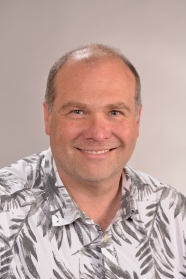Professor

- Location
- Room 420
- Phone numbers
- 4120 (Office)
64 3 479 4120 (Office Direct Dial) - craig.rodger@otago.ac.nz
- Research Group
- http://www.physics.otago.ac.nz/nx/space/space-physics-home.html
Biography
BSc Hons, PhD(Otago)
Beverly Chair in Physics (2019)
Fulbright New Zealand Scholar Award (2015)
University of Otago Excellence in Teaching Award (2011)
University of Otago Early Career Award for Distinction in Research (2004)
Editor's Citation for Excellence in Refereeing for the American Geophysical Union's Journal of Geophysical Research - Space Physics (1998 and 2014)
Inaugural Hatherton Award from the Royal Society of New Zealand (1997)
I am active in three different fields. One of these fields is "Space Weather" which examines the energy flows from the Sun and how it impacts the environment on and around the Earth. I am also active in the Atmospheric Electricity community, which focuses primarily on lightning and thunderstorms, and finally I have also undertaken some work on greenhouse gases emitted from transport.
For more information about publications see my research group's publications page.
My primary focus is in Space Weather. Currently, my main research question focuses on quantifying the level and significance of electron precipitation out of the Van Allen radiation belts into the Earth's atmosphere. I have led the development of modelling tools such that we can understand experimental measurements in terms of the magnitude of the changing precipitation flux levels. I have also gained expertise in working with and understanding satellite measurements of the electrons trapped in the Van Allen belts. Working with my close collaborators from the British Antarctic Survey, we have ~15 radio receivers in the Arctic and Antarctic which we use to undertake long range remote sensing of the Earth's upper atmosphere; and hence detect particle precipitation. We collaborate with other groups, to determine the significance of this precipitation to the chemistry of the atmosphere. While my work is primarily "basic" Space Physics, our work has shown that it links to the wider understanding of the Earth's climate, and hence improving modelling of the climate in a CO2 dominated future.
My Atmospheric Electricity research currently revolves around global lightning detection. From its very first stages in 2002 I have been part of the World Wide Lightning Location Network (WWLLN), a network of radio receivers scattered around the world but linked by the internet. My research in this area focuses on improving the detection efficiency and location accuracy of the lightning detections provided by the network. Our group operates one of the two central processing computers of the WWLLN network at Otago and sensors in Dunedin, Scott Base, and Edmonton (Canada).
Finally, I have recently begun working with a colleague on the problem of carbon emissions from transport (e.g., aviation, cruise liners, etc).
Publications
Crack, M., Rodger, C. J., Clilverd, M. A., Mac Manus, D. H., Martin, I., Dalzell, M., … Peterson, T. (2024). Even-order harmonic distortion observations during multiple geomagnetic disturbances: Investigation from New Zealand. Space Weather, 22(5), e2024SW003879. doi: 10.1029/2024SW003879 Journal - Research Article
Clilverd, M. A., Rodger, C. J., Hendry, A. T., Lozinski, A. R., Sauvaud, J.-A., Lessard, M. R., & Raita, T. (2024). Improved energy resolution measurements of electron precipitation observed during an IPDP-type EMIC event. Journal of Geophysical Research: Space Physics, 129, e2024JA032785. doi: 10.1029/2024JA032785 Journal - Research Article
Smith, A. W., Rodger, C. J., Mac Manus, D. H., Rae, I. J., Fogg, A. R., Forsyth, C., Fisher, P., … Dalzell, M. (2024). Sudden commencements and geomagnetically induced currents in New Zealand: Correlations and dependance. Space Weather, 22, e2023SW003731. doi: 10.1029/2023SW003731 Journal - Research Article
Mac Manus, D. H., Rodger, C. J., Renton, A., Ronald, J., Harper, D., Taylor, C., … Clilverd, M. A. (2023). Geomagnetically induced current mitigation in New Zealand: Operational mitigation method development with industry input. Space Weather, 21, e2023SW003533. doi: 10.1029/2023SW003533 Journal - Research Article
Chapman-Smith, K., Seppälä, A., Rodger, C. J., Hendry, A., & Forsyth, C. (2023). Observed loss of polar mesospheric ozone following substorm-driven electron precipitation. Geophysical Research Letters, 50, e2023GL104860. doi: 10.1029/2023GL104860 Journal - Research Article